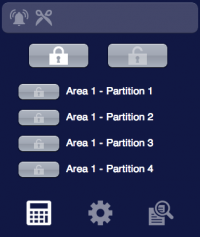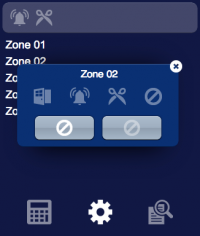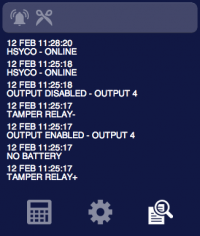Difference between revisions of "Elmo"
Jump to navigation
Jump to search
| Line 38: | Line 38: | ||
|rowspan="2"|true | |rowspan="2"|true | ||
|true | |true | ||
| − | |enable support for the UI | + | |enable support for the UI object, UISET actions and USER commands |
|- | |- | ||
|false | |false | ||
Revision as of 17:04, 20 December 2013
EL.MO. ETR100 is a multi-area intrusion detection system. The integration with HSYCO can be accomplished via direct control through the RS232 port on the panel.
Contents
Communication
Employ the RS-232 cable provided with the EL.MO. panel to connect it directly to HSYCO or to an Ethernet/RS-232 gateway.
RS-232 parameters:
| Baud rate | 9600 |
| Data bits | 8 |
| Stop bit | 1 |
| Parity | none |
| Flow control | none |
HSYCO Configuration
Options
| ID | Default | Values | Description |
|---|---|---|---|
| gui | true | true | enable support for the UI object, UISET actions and USER commands |
| false | disable UI support | ||
| startupevents | false | true | generate IO events also during the driver’s start-up phase |
| false | start generating events only after HSYCO is aligned with the current status of the system | ||
| offlinelogs | true | false | at startup request the log of all the events occurred while HSYCO was disconnected from the panel |
| false | log only events occurred while HSYCO was connected to the panel | ||
| pollinterval | 1 | n > 0 | the data acquisition interval, in seconds |
| logsize | 20 | n ≥ 0 | the number of log lines to display in the UI object |
Datapoints
| ID | Value | R/W | Description |
|---|---|---|---|
| connection | online | R | connection established |
| offline | R | HSYCO can't connect to the panel | |
| armed | 1 | R | at least one partition is armed |
| W | arm all active areas | ||
| 0 | R | no partition is armed | |
| W | disarm all active areas | ||
| armed.max | 1 | R | at least one partition is armed in "max security" mode |
| W | arm all active areas in "max security" mode | ||
| 0 | R | no partition is armed in "max security" mode | |
| W | disarm all active areas in "max security" mode | ||
| alarm | 1 | R | alarm state active |
| 0 | R | no active alarm | |
| tamper | 1 | R | tamper alarm active |
| 0 | R | no active tamper alarm | |
| i<n>.name | <text> | R | the name of input <n> is set to <text> |
| i<n>.open | 1 | R | input <n> open |
| 0 | R | input <n> closed | |
| i<n>.alarm | 1 | R | alarm on input <n> |
| 0 | R | no alarm on input <n> | |
| i<n>.tamper | 1 | R | tamper alarm on input <n> |
| 0 | R | no tamper alarm on input <n> | |
| i<n>.bypassed | 1 | R | input <n> bypassed |
| W | bypass input <n> | ||
| 0 | R | input <n> enabled | |
| W | enable input <n> | ||
| o<n> | 1 | R | output <n> active |
| W | activate output <n> | ||
| 0 | R | output <n> inactive | |
| W | deactivate output <n> | ||
| a<n>.<m>.name | <text> | R | the name of partition <m> of area <n> is set to <text> |
| a<n>.armed | 1 | W | arm all partitions of area <n> |
| 0 | W | disarm all partitions of area <n> | |
| a<n>.armed.max | 1 | W | arm all partitions of area <n> in "max security" mode |
| 0 | W | disarm all partitions of area <n> in "max security" mode | |
| a<n>.<m>.armed | 1 | R | partition <m> of area <n> is armed |
| W | arm partition <m> of area <n> | ||
| 0 | R | partition <m> of area <n> is disarmed | |
| W | disarm partition <m> of area <n> | ||
| a<n>.<m>.armed.max | 1 | R | partition <m> of area <n> is armed in "max security" mode |
| W | arm partition <m> of area <n> in "max security" mode | ||
| 0 | R | partition <m> of area <n> is not armed in "max security" mode | |
| W | disarm partition <m> of area <n> in "max security" mode | ||
| usr<n>.name | <text> | R | the name of user <n> is set to <text> |
| kp<n>.tamper | 1 | R | keypad <n> tampered |
| 0 | R | keypad <n> not tampered | |
| fault.battery | 1 | R | battery fault active |
| 0 | R | no battery fault active | |
| panel.tamper | 1 | R | panel tampered |
| 0 | R | panel not tampered | |
| rel.tamper | 1 | R | tamper relay is on |
| 0 | R | tamper relay is off | |
| rel.alarm | 1 | R | alarm relay is on |
| 0 | R | alarm relay is off |
User Interface
Elmo Object
The user interface for the EL.MO. multi-area intrusion detection system:
The (elmo) object is listed in the Project Editor’s new object list only when at least one EL.MO. I/O Server is defined
Parameters
- server id: the server ID. Supports Redirect variables
- area: the area. Supports Redirect variables
- position: the object's position. Use the pixels or rows and columns coordinates format
Syntax
(elmo <server id>; <area>; <position>)
E.g.
(elmo elm; 1; x10y20)
UISET Actions
| ID | Attribute | Set to | |
|---|---|---|---|
| log | text | latest security log lines (as many as specified by the 'logsize' option) | |
| log0 | text | latest line of the security log when a new entry is added, set back to blank after a short period | |
| i<n>.name | text | name assigned to input <n> | |
| a<n>.<m>.name | text | name assigned to partition <m> of area <n> | |
| usr<n>.name | text | name assigned to user <n> | |
| connection.label | visible | true | when datapoint connection = offline |
| false | when datapoint connection = online | ||
| <datapoint_id>.label.1 | visible | true | when datapoint with ID <datapoint_id> has value '1' |
| false | when datapoint with ID <datapoint_id> has value '0' | ||
| <datapoint_id>.label.0 | visible | true | when datapoint with ID <datapoint_id> has value '0' |
| false | when datapoint with ID <datapoint_id> has value '1' | ||
USER Commands
| Name | Param | Action |
|---|---|---|
| armed | 1 | arm all active areas |
| 0 | disarm all active areas | |
| armed.max | 1 | arm all active areas in "max security" mode |
| 0 | disarm all active areas in "max security" mode | |
| ID.a<n>.armed | 1 | arm all partitions of area <n> |
| 0 | disarm all partitions of area <n> | |
| a<n>.armed.max | 1 | arm all partitions of area <n> in "max security" mode |
| 0 | disarm all partitions of area <n> in "max security" mode | |
| a<n>.<m>.armed | 1 | arm partition <m> of area <n> |
| 0 | disarm partition <m> of area <n> | |
| a<n>.<m>.armed.max | 1 | arm partition <m> of area <n> in "max security" mode |
| 0 | disarm partition <m> of area <n> in "max security" mode | |
| i<n>.bypassed | 1 | bypass input <n> |
| 0 | enable input <n> | |
| o<n> | 1 | activate output <n> |
| 0 | deactivate output <n> |


